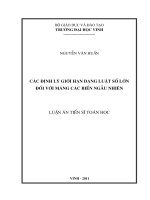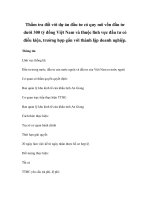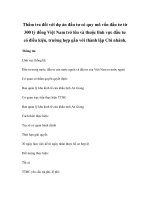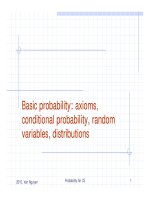Lý thuyết Xác suất cơ bản: các tiên đề, có điều kiện xác suất, các biến ngẫu nhiên, phân phối pps
Bạn đang xem bản rút gọn của tài liệu. Xem và tải ngay bản đầy đủ của tài liệu tại đây (191.01 KB, 26 trang )
Basic probability: axioms,
2010, Van Nguyen
Probability for CS 1
Basic probability: axioms,
conditional probability, random
variables, distributions
Application: Verifying Polynomial
Identities
Computers can make mistakes:
Incorrect programming
Hardware failures
sometimes, use randomness to check output
Example: we want to check a program that multiplies
2010, Van Nguyen
Probability for CS 2
Example: we want to check a program that multiplies
together monomials
E.g: (x+1)(x-2)(x+3)(x-4)(x+5)(x-6) ?= x
6
-7x
3
+25
In general check if F(x) = G(X) ?
One way is:
Write another program to re-compute the coefficients
That’s not good: may goes same path and produces the same
bug as in the first
How to use randomness
Assume the max degree of F & G is d. Use this algorithm:
Pick a uniform random number from:
{1,2,3, … 100d}
Check if F(r)=G(r) then output “equivalent”, otherwise “non-
equivalent”
Note: this is much faster than the previous way
–
O(d) vs. O(d
2
)
2010, Van Nguyen
Probability for CS 3
Note: this is much faster than the previous way
–
O(d) vs. O(d
2
)
One-sided error:
“non-equivalent” always true
“equivalent” can be wrong
How it can be wrong:
If accidentally picked up a root of F(x)-G(x) = 0
This can occur with probability at most 1/100
Axioms of probability
We need a formal mathematical setting for analyzing
the randomized space
Any probabilistic statement must refer to the underlying
probability space
Definition 1: A probability space has three
components:
2010, Van Nguyen
Probability for CS 4
components:
A sample space , which is the set of all possible outcomes of
the random process modeled by the probability space
A family of sets representing the allowable events, where
each set in
F is a subset of the sample space and
A probability function Pr: FR satisfying definition 2 below
An element of
W is called a
simple
or
elementary
event
In the randomized algo for verifying polynomial
identities, the sample space is the set of integers
{1,…100d}.
Each choice of an integer r in this range is a simple event
Axioms
Def2: A probability function is any function Pr: FR that
satisfies the following conditions:
1. For any event E, O Pr(E) 1;
2. Pr
(W) =1; and
3. For any sequence of pairwise mutually disjoint events E
1
, E
2,
E
3
…,
2010, Van Nguyen
Probability for CS 5
1
2,
3
Pr(
i
1
E
i
) =
i
1
Pr(E
i
)
events are sets use set notation to express event combination
In the considered randomized algo:
Each choice of an integer r is a simple event.
All the simple events have equal probability
The sample space has 100d simple events, and the sum of the
probabilities of all simple events must be 1
each simple event
has probability 1/100d
Lemmas
Lem1: For any two events E
1
, E
2
:
Pr(E
1
E
2
)= Pr(E
1
) + Pr(E
2
)- Pr(E
1
E
2
)
Lem2(Union bound): For any finite of countably
infinite sequence of events E
1
, E
2
, E
3
…,
2010, Van Nguyen
Probability for CS 6
1
2
3
Pr(
i
1
E
i
)
i
1
Pr(E
i
)
Lem3(inclusion-exclusion principle) Let E
1
, E
2
, E
3
… be
any n events. Then
Pr(
i
=1,n
E
i
) =
i
=1,n
Pr(E
i
) -
i
<j
Pr(E
j
E
j
) +
i
<j<k
Pr(E
j
E
j
E
k
) - …
+(-1)
l+1
i
1
i
r
Pr( r
=1,l
E
i
r
) +…
Analysis of the considered
algorithm
The algo gives an incorrect answer if the random
number it chooses is a root of polynomial F-G
Let E represent the event that the algo failed to give
the correct answer
2010, Van Nguyen
Probability for CS 7
the correct answer
The elements of the set corresponding to E are the roots of
the polynomial F-G that are in the set of integer {1,…100d}
Since F-G has degree at most d then has no more than d
roots
E has at most d simple events
Thus, Pr( algorithm fails) = Pr(E) d/(100d) = 1/100
How to improve the algo for
smaller failure probability?
Can increase the sample space
E.g. {1,…, 1000d}
Repeat the algo multiple times, using
different random values to test
2010, Van Nguyen
Probability for CS 8
different random values to test
If F(r)=G(r) for just one of these many rounds
then output “non-equivalent”
Can sample from {1,…100d} many times with
or without replacements
Notion of independence
Def3: Two events E and F are independent iff (if and only if)
Pr(E
F)= Pr(E) . Pr(F)
More generally, events
E
1
, E
2
, …, E
k
are mutually independent iff for
any subset I
[1,k]: Pr(
iI
E
i
)= P
iI
Pr(E
i
)
Now for our algorithm samples with replacements
The choice in one iteration is independent from the choices in previous
2010, Van Nguyen
Probability for CS 9
The choice in one iteration is independent from the choices in previous
iterations
Let E
i
be the event that the i
th
run of algo picks a root r
i
s.t. F(r
i
)-
G(r
i
)=0
The probability that the algo returns wrong answer is
Pr(
E
1
E
2
… E
k
) = P
i=1,k
Pr(E
i
) P
i=1,k
(d/
100d
) = (1/
100
)
k
Sampling without replacement:
The probability of choosing a given number
is conditioned on
the
events of the previous iterations
Notion of conditional probability
Def 4: The condition probability that event E
occurs given that event F occurs is
Pr(E|F) =
Pr(EF)
/
Pr(F)
Note this con. pro. only defined if Pr(F)>0
2010, Van Nguyen
Probability for CS 10
Note this con. pro. only defined if Pr(F)>0
When E and F are independent and Pr(F)>0 then
Pr(E|F) =
Pr(EF)
/
Pr(F)
=
Pr(E).Pr(F)
/
Pr(F)
= Pr(E)
Intuitively, if two events are independent then
information about one event should not affect the
probability of the other event.
Sampling without replacement
Again assume FG
We repeat the algorithm k times: perform k iterations of
random sampling from [1,…100d]
What is the prob that all k iterations yield roots of F-G,
resulting in a wrong output by our algo?
2010, Van Nguyen
Probability for CS 11
resulting in a wrong output by our algo?
Need to bound Pr(E
1
E
2
… E
k
)
Pr(E
1
E
2
… E
k
)= Pr(E
k
|E
1
… E
k-1
) . Pr(E
1
E
2
… E
k-1
)
= Pr(E
1
). Pr(E
1
|E
2
). Pr(Pr(E
3
|E
1
E
2
). … Pr(E
k
|E
1
… E
k-1
)
Need to bound Pr(E
j
|E
1
… E
kj1
):
d-(j-1)
/
100d-(j-1)
So Pr(E
1
E
2
… E
k
) P
j=1,k
d-(j-1)
/
100d-(j-1)
(
1
/
100
)
k
, slightly better
Use d+1 iterations: always give correct answer. Why?
Efficient?
Random variables
Def 5: A random variable X on a sample
space
W is a real-valued function on W; that
is X:
WR. A discrete random variable is a
random variable that takes on only finite or
2010, Van Nguyen
Probability for CS 12
random variable that takes on only finite or
countably infinite number of values
So, “X=a” represents the set {s |X(s)=a}
Pr(X=a) =
X(s)=a
Pr(s)
Eg. Let X is the random variable representing the
sum of the two dice. What is the prob of X=4?
Random variables
Def6: Two random variables X and Y are
independent iff for all values x and y:
Pr( (X=x)
(Y=y)) = Pr(X=x)
. Pr(
Y=y)
2010, Van Nguyen
Probability for CS 13
Pr( (X=x)
(Y=y)) = Pr(X=x)
. Pr(
Y=y)
Expectation
Def 7: The expectation of a discrete
random variable X, denoted by E[X] is
given by E[X] =
i
iPr(X=i)
2010, Van Nguyen
Probability for CS 14
i
where the summation is over all values in
range of X
E.g Compute the expectation of the
random variable X representing the sum of
two dice
Linearity of expectation
Theorem:
E[
i=1,n
X
i
] =
i=1,n
E[X
i
]
E[c X] = c E[X] for all constant c
2010, Van Nguyen
Probability for CS 15
E[c X] = c E[X] for all constant c
Bernoulli and Binomial random
variables
Consider experiments that succeeds with probability p
and fails with probability 1-p
Let Y be a random variable takes 1 if the experiment succeeds
and 0 if otherwise. Called a Bernoulli or an indicator random
variable
2010, Van Nguyen
Probability for CS 16
variable
E[Y] = p
Now we want to count X, the number of success in n tries
A binomial random variable X with parameters n and p,
denoted by B(n,p), is defined by the following probability
distribution on j=0,1,2,…, n:
Pr(X=j) = (n choose j) p
j
(1-p)
n-j
E.g. used a lot in sampling (book: Mit-Upfal)
The hiring problem
HIRE-ASSISTANT(
n
)
1
best
←0
candidate 0 is a least-qualified dummy candidate
2
for
i
←
1
to
n
2010, Van Nguyen
Probability for CS 17
2
for
i
←
1
to
n
3 do interview candidate
i
4 if candidate
i
is better than candidate
best
5 then
best
←
i
6 hire candidate
i
We are not concerned with the running time of
HIRE-ASSISTANT, but instead with the cost
incurred by interviewing and hiring.
Interviewing has low cost, say
c
i
, whereas hiring
is expensive, costing
c
h
. Let
m
be the number of
Cost Analysis
2010, Van Nguyen
Probability for CS 18
is expensive, costing
c
h
. Let
m
be the number of
people hired. Then the cost associated with this
algorithm is
O
(
nc
i
+
mc
h
). No matter how many
people we hire, we always interview
n
candidates and thus always incur the cost
nc
i
,
associated with interviewing.
Worst-case analysis
In the worst case, we actually hire
every candidate that we interview. This
situation occurs if the candidates come
in increasing order of quality, in which
2010, Van Nguyen
Probability for CS 19
in increasing order of quality, in which
case we hire n times, for a total hiring
cost of
O
(
nc
h
).
Probabilistic analysis
Probabilistic analysis
is the use of
probability in the analysis of problems. In
order to perform a probabilistic analysis, we
must use knowledge of the distribution of the
2010, Van Nguyen
Probability for CS 20
must use knowledge of the distribution of the
inputs.
For the hiring problem, we can assume that
the applicants come in a random order.
Randomized algorithm
We call an algorithm
randomized
if
its behavior is determined not only by
its input but also by values produced
2010, Van Nguyen
Probability for CS 21
its input but also by values produced
by a
random-number generator
.
Indicator random variables
1
[ ]
I A
i f A occur s
The indicator random variable I[A]
associated with event A is defined as
2010, Van Nguyen
Probability for CS 22
[ ]
0
I A
i f A does not occur
• Lemma: Given a sample space and an
event A in the sample space
, let X
A
=I{A}.
Then E[X
A
]=Pr(A).
Analysis of the hiring problem
using indicator random variables
Let X be the random variable whose value
equals the number of times we hire a new
office assistant and X
i
be the indicator random
variable associated with the event in which
2010, Van Nguyen
Probability for CS 23
variable associated with the event in which
the ith candidate is hired. Thus,
X=X
1
+X
2
+…+X
n
By the lemma above, we have
E[X
i
]=Pr{ candidate i is hired}=1/i. Thus,
E[X]=1+1/2+1/3+…+1/n=ln n+O(1)
Randomized algorithms
RANDOMIZED-HIRE-ASSISTANT(
n
)
1 randomly permute the list of candidate
2
best
←0
3
for
i
←
1
to
n
2010, Van Nguyen
Probability for CS 24
3
for
i
←
1
to
n
4 do interview candidate
i
5 if candidate
i
is better than candidate
best
6 then
best
←
i
7 hire candidate
i
PERMUTE-BY-SORTING(
A
)
1
n
←
length
[
A
]
2
for
i
←1 to
n
3
do
P
[
i
]
←
RANDOM(1,
n
3
)
2010, Van Nguyen
Probability for CS 25
3
do
P
[
i
]
←
RANDOM(1,
n
)
4 sort
A
, using
P
as sort keys
5
return
A
Lemma:
Procedure PERMUTE-BY-SORTING
produces a uniform random permutation of input,
assuming that all priorities are distinct.









